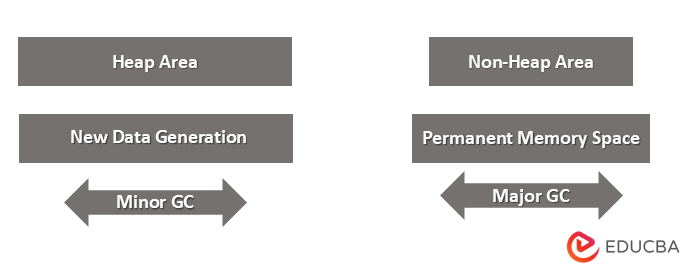Introduction to Java Garbage Collection
The garbage collection will involve having scanning for heap memory to determine which items are being selected and identified being used that eliminate the latter and reference the object or an object that is still being used by the software application has a pointer also it’s a way to destroy the unused objects by using the default methods along with JVM to make extra efforts for cleaning the tasks.
Table of Content
- Introduction
- What is Java Garbage Collection?
- How does Java Garbage Collection work?
- Types of Java Garbage Collection
- Phases of Garbage Collection
- Comparison and Performance of Garbage Collection
- Implementations of Java Garbage Collection
- Example
Key Takeaways
- To ensures that a program’s memory limit is not exceeded or reached to the point where it is no longer functional analysis.
- JVM determines the memory that is no longer required by the java application so it can be recycled.
- To request that the garbage collector be called by the JVM, utilize the static method gc() of the System class.
- Garbage Collection in Java is in charge of memory management.
- There are different GC, and each has a different level of application throughput and pause.
What is Java Garbage Collection?
Garbage collection will entail scanning heap memory to identify which items are being used, eliminating later, and referencing the object or an object that is still being used by the software application as a pointer. It will also involve a way to destroy the unused objects by using the JVM’s default methods as well as extra work to complete the cleaning tasks. Making the reference invalid and designating someone with a reference object it holds and taking consumption of memories used by an unidentified object, etc.
How does Java Garbage Collection work?
The JVM views as a separate item that can be used alive so long as it is being referenced by another object. The garbage collector eliminates an object after it is no longer referenced and thus not available by the application code, it helps to free up the memory that it occupied. Based on the memory allocation that is being made used by the optimizing engine and chosen the ideal moment to conduct the collections. Once it completes a collection frees up the memory for each set of objects that are no longer being used to examine the application root to identify the items. Mainly the static fields, and local variables on a thread stack collecting CPU registers to handle the GC and monitor the Queue operations. The application root will either an item on the managed heap which is referenced by each set of roots is to set null and can be requested from the rest of the runtime by the garbage collectors.
The above lists will help to identify and use the garbage collector for building the graph model that includes all the separate items same will be accessed from the root node.
Types of Java Garbage Collection
In Java, there are four different types of garbage collectors that can be mainly employed depending on the situation which handled by the user requirement.
1. Serial Garbage Collector
It is one of the GC method implementations for executing the application thread process. It started a multi-threaded flow along with the separate parameters. The argument that follows can be used to activate the Serial Garbage Collector:
java -XX:+UseSerialGC -jar FileName.java
2. Parallel Garbage Collector
Throughput Collectors is also referred to as the same name for the JVM’s default garbage collector. It uses several threads, that mainly collect the memory space to run the java thread parallelly. The below code is activation for the parallel Garbage collector.
java -XX:+UseParallelGC -jar FileName.java.
3. Garbage First(G1) Garbage Collector
The G1 garbage collector is being accessible for starting with JDK versions with Updates for subsequent editions. It produces better performance and performs the Garbage information. Below line for activation,
java -XX:+UseG1GC -jar FileName.java
4. Concurrent Mark Sweep(CMS) Garbage Collector
In the CMS GC, multiple threads are configured with the programmers along with separate thread resources for each process task. Below line for activation,
java -XX:+UseParNewGC -jar FileName.java.
Phases of Garbage Collection
- Mark: Begins from the root node of your application (e.g., main method). Traverses the object graph, marking objects that are reachable as live.
- Delete/Sweep: Deletes unreachable objects. Deletion creates holes in the heap, leading to fragmentation. Compaction is often employed to address fragmentation.
- Compacting: Involves rearranging objects in memory by moving them around. The aim is to make memory allocation more contiguous and reduce fragmentation. Compaction is a time-consuming task but helps in optimizing memory usage.
Comparison and Performance of Garbage Collection
| GC Types | Basic Concept | Use Cases |
|
Serial Garbage Collector |
|
|
|
Parallel Garbage Collector |
|
|
|
CMS Collector |
|
|
|
G1 Collector |
|
|
Performance Table
| Criteria | Serial GC | Parallel GC | CMS GC | G1 GC |
| Throughput | Moderate | High | Moderate | High |
| Pause Times | Short | Moderate | Short | Short Moderate |
| Memory Footprint | Low | Moderate | Moderate | Moderate |
| Scalability | Limited | Good | Limited | Good |
Implementations of Java Garbage Collection
The JVM houses the garbage collection implementation. Garbage collection implementation is completely up to each JVM; the only condition is that it adheres to the JVM specification. The age-based classification is mainly used by java garbage collectors as part of their generational garbage collection technique. It is mainly inefficient to designate and condense with each object in JVM as longer trash collection times will result from the list of objects that helps to allocate the items.
The majority of java objects are mainly according to programmer analysis with some lifespan. Heap memory of the JVM area is mainly classified into major and minor Garbage Collectors.
Importance
It ensures that the programmer does not use up all its memory allotment which gets to the point where it becomes unusable. Additionally, the programmers manage the memory manually with possible memory-related problems. It automatically handles the memory deletion for unused objects so it will reach free vital memory resources. The unused managed memory will free the programmers from possible memory-related problems. Java program’s performance may be adverse with unexpected ways for frequent GC activities. It will increase CPU maintenance and burdens slowdown the application operations.
The ultimate ways and affects for end users will interact with the java based applications for slowing down the business transactions execution. A memory leaked will be mainly task and excessive GC activities to increase the JVM memory allocation for CPU tends to grow it that helps to much memory and trash activities.
Example
Code:
import java.util.*;
public class NewTest {
public static void main(String[] args)
{
NewTest n1=new NewTest();
NewTest n2=new NewTest();
n1=null;
n2=null;
System.out.println("Welcome");
System.gc();
}
}Output:
- In the above example, we created 1 class.
- And using the main method to create the instance of the classes.
- Here we created 2 instances on the same class and assign the value as null.
- Then using System.gc() method to clean up the unused memory instances.
Conclusion
Unreferenced objects are automatically deleted from the heap memory as a result of garbage collection, which makes Java memory-efficient. The programmer is freed from having to manage memory deallocation manually thanks to garbage collection. We choose a waste collector after conducting adequate testing under the production load which because there are various options already available.
Recommended Articles
This is a guide to Java Garbage Collection. Here we discuss the introduction, working, types, and implementation of java garbage collection along with an example and importance. You may also have a look at the following articles to learn more –





